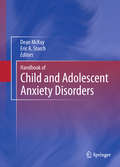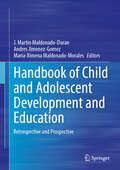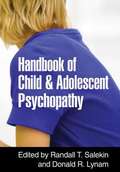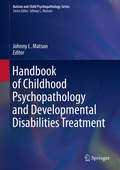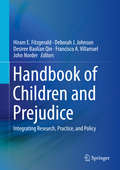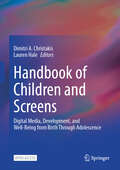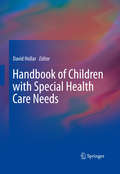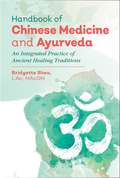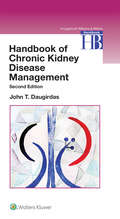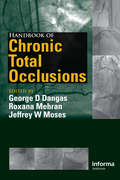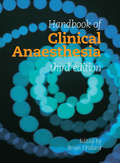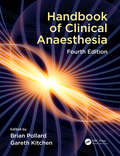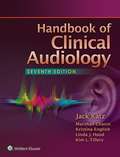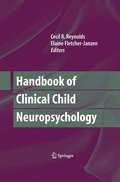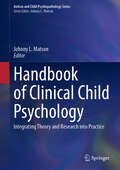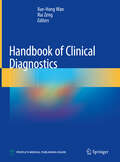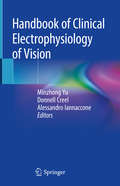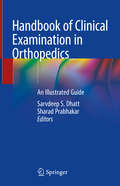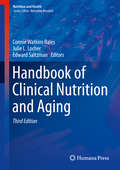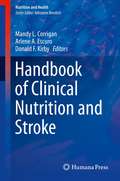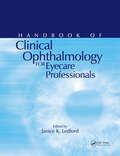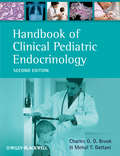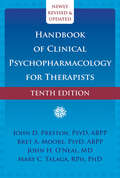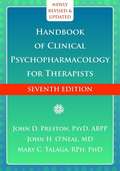- Table View
- List View
Handbook of Child and Adolescent Anxiety Disorders
by Dean Mckay Eric A. StorchIs it school refusal or separation anxiety disorder? Can preschoolers have panic attacks? Does food neophobia really exist? For readers seeking ways to improve assessment, case conceptualization, or treatment plans as well as a more general understanding of anxiety disorders among children, the Handbook of Child and Adolescent Anxiety Disorders addresses these and many other complex issues. A straightforward companion to the diagnostic manuals, this volume crosses theoretical boundaries to describe in depth the wide range of children's anxiety disorders and to explain the developmental nuances that separate them from their adult analogues. Coverage includes: Diagnostic and etiological models of children's anxiety disorders (i.e., genetic, cognitive-behavioral, taxonomic, neuropsychological, dimensional). Differential diagnosis guidelines for generalized anxiety disorder (GAD), phobic conditions, obsessive-compulsive disorder (OCD), and posttraumatic stress disorder (PTSD) in youth. Ancillary factors in child and adolescent anxiety (e.g., personality, temperament, parenting issues, and comorbid conditions). Psychological, pharmacological, and combined treatments for childhood anxiety disorders. Special populations and emerging areas of interest, including anxiety disorders in the contexts of chronic health problems and developmental disabilities. The Handbook of Child and Adolescent Anxiety Disorders is a must-have reference for researchers, clinicians, and graduate students in psychology, psychiatry, social work and counseling as well as allied professionals in hospitals, community mental health centers, schools, and private practice.
Handbook of Child and Adolescent Development and Education: Retrospective and Prospective
by J. Martin Maldonado-Duran Andres Jimenez-Gomez Maria-Ximena Maldonado-MoralesThis book examines foundational child development theories and research that continue to inform and guide contemporary state-of-the art research and practice. It goes beyond a behavior-only focus to address key child development issues, including emotional life and lived experiences as well as family and sociocultural contexts. The volume details classic neurological and neuropsychological research discoveries and insights that can be adapted and incorporated into current clinical practices with infants, children, and adolescents. In addition, it addresses neurophysiology and its relationship to several aspects of child development, including intersubjectivity, mirror neurons, emotional attunement, and intercorporeity. The book explores various systems of child and adolescent psychotherapy as well as the effects of emotional trauma, risk and protective factors, resilience, and the importance of early intervention and prevention on child development. Key areas of coverage include Human ethology and its impact on understanding of biological biases. Specialized intelligence and parent-child interactions from an evolutionary point of view. Past and present child psychiatry and psychotherapy concepts and their impact on clinical practice. Education and its effects on child development and behavior. Children&’s cognitive and emotional development research with current clinical implications and uses. Parent-infant attachment and its implications. The Handbook of Child and Adolescent Development and Education is a must-have resource for researchers, professors, and graduate students as well as clinicians and related therapists and professionals in clinical child psychology, child and adolescent psychiatry, pediatrics, developmental psychology, neuropsychology, social work, neurology, school psychology and all related disciplines.
Handbook of Child and Adolescent Psychopathy
by Randall Salekin Donald LynamThis comprehensive handbook synthesizes the rapidly growing research base on child and adolescent psychopathy: its nature, causes, development, assessment, and treatment. The editors and contributors are leading authorities who review state-of-the-art empirical findings and weigh in on pressing questions, such as how the disorder should be conceptualized in youth and how to evaluate it in clinical and forensic contexts. Available assessment instruments and intervention approaches are critically examined. Etiological theories are presented that shed light on a range of potential causal mechanisms, including genetics, brain functioning, temperament, family processes, and other factors.
Handbook of Childhood Psychopathology and Developmental Disabilities Treatment (Autism and Child Psychopathology Series)
by Johnny L. MatsonThis handbook explores the rapid growth in childhood developmental disabilities (DD) treatments. It reviews current evidence-based treatments for common psychopathologies and developmental disorders and evaluates the strengths of the treatments based on empirical evidence. Spanning infancy through the transition to young adulthood, chapters provide definitions, etiologies, prevalence, typical presentation and variants, assessment and diagnostic information, and age considerations. Chapters also review established and emerging psychological approaches and pharmacotherapies for cognitive, behavioral, emotional, medical, academic, and developmental issues as diverse as mood disorders, the autism spectrum, memory problems, feeding disorders, Tourette syndrome, and migraines. The wide range of topics covered aids practitioners in working with the complexities of young clients’ cases while encouraging further advances in an increasingly relevant field. Topics featured in this handbook include:An introduction to Applied Behavior Analysis.Parent training interventions.Treatment strategies for depression in youth.Assessment and treatment of self-injurious behaviors in children with DD. Treatment approaches to aggression and tantrums in children with DD.Interventions for children with eating and feeding disorders. The Handbook of Childhood Psychopathology and Developmental Disabilities Treatment is a must-have resource for researchers, graduate students, clinicians, and related therapists and professionals in clinical child and school psychology, pediatrics, social work, developmental psychology, behavioral therapy/rehabilitation, child and adolescent psychiatry, and special education.
Handbook of Children and Prejudice: Integrating Research, Practice, and Policy
by Deborah J. Johnson Hiram E. Fitzgerald Desiree Baolian Qin Francisco A. Villarruel John NorderThis handbook examines the effects and influences on child and youth development of prejudice, discrimination, and inequity as well as other critical contexts, including implicit bias, explicit racism, post immigration processes, social policies, parenting and media influences. It traces the impact of bias and discrimination on children, from infancy through emerging adulthood with implications for later years. The handbook explores ways in which the expanding social, economic, and racial inequities in society are linked to increases in negative outcomes for children through exposure to adverse childhood experiences (ACEs). Chapters examine a range of ACEs – low income, separation/divorce, family substance abuse and mental illness, exposure to neighborhood and/or domestic violence, parental incarceration, immigration and displacement, and parent loss through death. Chapters also discuss discrimination and prejudice within the adverse experiences of African American, Asian American, European American, Latino, Native American, Arab American, and Sikh as well as LGBTQ youth and non-binary children. Additionally, the handbook elevates dynamic aspects of resilience, adjustment, and the daily triumphs of children and youth faced with issues related to prejudice and differential treatment.Topics featured in the Handbook include:The intergenerational transmission of protective parent responses to historical trauma.The emotional impact of the acting-white accusation.DREAMers and their experience growing up undocumented in the USA.Online racial discrimination and its relation to mental health and academic outcomes.Teaching strategies for preventing bigoted behavior in class.Emerging areas such as sociopolitical issues, gender prejudice, and dating violence. The Handbook of Children and Prejudice is a must-have resource for researchers, graduate students, clinicians, therapists, and other professionals in clinical child and school psychology, social work, public health, developmental psychology, pediatrics, family studies, juvenile justice, child and adolescent psychiatry, and educational psychology.
Handbook of Children and Screens: Digital Media, Development, and Well-Being from Birth Through Adolescence
by Dimitri A. Christakis Lauren HaleThis open access handbook synthesizes the current research about the impacts of digital media on children across development. Drawing on the expertise of scientists and researchers as well as clinicians and practitioners, the book summarizes research through interdisciplinary expert reviews. First, it addresses the cognitive, physical, mental, and psychosocial impacts on infants, children, and adolescents. Next, the book explores how media influences relationships, family, culture, and society. Finally, it examines the impacts of specific digital domains pertinent to youth, including education technology, video gaming, and emerging technologies. Chapters employ a parallel structure, including background on the topic, summary of the current state of the research, future research directions, and recommendations for relevant stakeholders. The volume examines the timely issue of optimal child development in an increasingly digital age, offering innovative approaches to establish a solid and robust scientific foundation for this field of study as well as evidence-based action for adults who support positive youth development. Key areas of coverage include: • Cognition and brain development. • Physical and mental health. • Problematic uses of the internet. • Race. • Gender and sexuality. • Parenting in the digital age. • Cyberbullying and digital cruelty. • Media policy. The Handbook of Children and Screens is a must-have resource for researchers, professors, and graduate students as well as clinicians, therapists, educators, and related professionals in clinical child, school, and developmental psychology, social work, public health, epidemiology, neuroscience, human development and family studies, social psychology, sociology, and communication. This is an open access book.
Handbook of Children with Special Health Care Needs
by David HollarChildren with chronic conditions, developmental disorders, and birth defects represent a sizeable minority of American children--as many as one in five. Often their families have financial or other issues limiting their access to appropriate care, thus limiting their adult prospects as well. Compounding the problem, many valuable resources concerning this population are difficult to access although they may be critical to the researchers, practitioners, and policymakers creating standards for quality care and services. In response, the Handbook of Children with Special Health Care Needs assembles research, applied, and policy perspectives reflecting the range of children's problems requiring special services. Widely studied conditions (e.g., communication disorders, substance abuse) and those receiving lesser attention (e.g., tuberculosis) are covered, as are emerging ideas such as the "medical home" concept of continuity of care. Its interdisciplinary outlook makes the Handbook of Children with Special Health Care Needs a vital, forward-looking text for developmental psychologists, pediatricians, early childhood and special education researchers and practitioners, disability researchers, policymakers, and advocates, and providers for children with special health care needs.
Handbook of Chinese Medicine and Ayurveda: An Integrated Practice of Ancient Healing Traditions
by Bridgette SheaA comprehensive reference tool for maximizing healing of the mind, body, and spirit through a holistic synergy of Chinese medicine and Ayurveda • Details the foundational principles of each tradition and the many concepts they share, such as qi and prana, meridians and nadis, and energy centers and chakras • Provides tools for self-assessment including a primer on tongue diagnosis and a mental, emotional, and physical constitutional questionnaire • Offers breathing exercises, dietary regimens, herbal recommendations, and guides for detoxification, including safe and gentle at-home cleansing Chinese medicine and Ayurveda are two of the oldest healing systems in use today. Each is a complete art, in and of itself, and has profoundly contributed to the health and well-being of millions of people around the world. Drawing on their shared roots and spiritual principles, Bridgette Shea, L.Ac., MAcOM, shows how these two practices integrate seamlessly, with the two traditions’ individual strengths harmonizing to form a practical basis for prevention, wellness, detoxification, and treatment. The author explains the foundational principles of both Chinese medicine and Ayurveda in detail, providing the reader with a working understanding of both disciplines. She examines shared concepts such as qi and prana, meridians and nadis, and energy centers and chakras. She explores the strengths of each practice, such as the clinical efficiency of diagnosis and the use of acupuncture for pain relief, improving fertility, and stress reduction in Chinese medicine and the dietary, detoxification, and spiritual guidance of Ayurveda, including the detox branch of Ayurveda known as Panchakarma. Moving beyond theory into practical application, she explores the Elements, known as the Five Phases and the Panchamahabhutas, and how they affect our well-being. She provides tools for self-assessment including a primer on tongue diagnosis and a mental, emotional, and physical constitutional questionnaire. Offering treatment and prevention strategies that draw from both disciplines, she encourages the reader to implement an integrated practice of these two systems in daily life or clinical practice. She details breathing exercises, dietary regimens, herbal recommendations, and guides for detoxification, including safe and gentle home cleanses, all rooted in the holistic synergy between Ayurveda and Chinese medicine. Sharing case studies that highlight the interconnectedness of these approaches, Shea provides a comprehensive guide for self-healing of body, mind, and spirit and a practitioner’s resource to cross-reference complex questions with respect to both healing traditions.
Handbook of Chiral Chemicals
by Ian MuehlenhausAs pharmaceutical companies look to develop single enantiomers as drug candidates, chemists are increasingly faced with the problems associated with this subclass of organic synthesis. "The Handbook of Chiral Chemicals, Second Edition" highlights the problems associated with the production of chiral compounds on a commercial scale. The handbook fir
Handbook of Chronic Kidney Disease Management: Stages 1-4 (A\lippincott Williams And Wilkins Handbook Ser.)
by John DaugirdasPublisher's Note: Products purchased from 3rd Party sellers are not guaranteed by the Publisher for quality, authenticity, or access to any online entitlements included with the product. Offering authoritative coverage of all aspects of diagnosing, treating, and preventing the progression of chronic kidney disease (CKD), this highly regarded handbook is an invaluable resource for nephrologists, internists, nurse practitioners, physician assistants, and other healthcare professionals who care for early-stage CKD patients. Incorporating the considerable advances in the field since the previous edition, Handbook of Chronic Kidney Disease Management, 2nd Edition, provides a truly global perspective on managing patients with mild to moderate CKD.
Handbook of Chronic Total Occlusions
by George D. Dangas Roxana Mehran Jeff MosesChronic total occlusions (CTO) are common, and found in approximately one third of patients with significant coronary artery disease who undergo angiography. CTO constitute one of the main criteria when selecting between angioplasty and bypass surgery. Angioplasty for CTO is intricate and requires excellent operator skill, but even when perfor
Handbook of Clinical Anaesthesia 3E
by Brian PollardThe Handbook of Clinical Anaesthesia has been completely updated for this new edition, providing trainee anaesthetists with a concise but comprehensive source of clinical information, and qualified anaesthetists with an indispensable aide. Written and edited by experts in the field, this compact but detailed text provides all the essential practica
Handbook of Clinical Anaesthesia, Fourth edition
by Brian Pollard Gareth KitchenWritten and edited by experts in the field, the Handbook of Clinical Anaesthesia provides all the essential practical knowledge required by anaesthetists on co-existing medical conditions, operative procedures, and techniques. The fourth edition retains the concise and comprehensive nature of the third, giving readers all they need to know about each part of the FRCA syllabus in short, digestible, practical entries. <P><P> The first part covers Patient Conditions; the second Surgical Procedures; and the third Anaesthetic Factors. Each part is subdivided into chapter on each organ system, and each chapter is divided into bite-sized entries. These are in alphabetical order, and cover all common and rare conditions that anaesthetists will encounter within their practice. Avoiding prolonged discussion and multiple references, this is the ideal book to ‘dip into’ either for specific advice or general education, providing quick and reliable information. <P><P> This is the most thorough handbook to cover the entire FRCA syllabus in a consistent and instructive manner. It continues to be accessible and relevant to all anaesthetists from middle grade trainee up to consultant/specialist.
Handbook of Clinical Audiology
by Jack KatzPrepare your graduate students for their careers in audiology with Katz's Handbook of Clinical Audiology, Seventh Edition. This go-to resource was developed by an unsurpassed team of editors and authors, whose expertise in research and clinical practice spans all core areas of clinical audiology. <P><P>Packed with new research, relevant case studies, and today's best practices, the Seventh Edition has been extensively revised and updated throughout and features six all-new chapters, updated research, a streamlined table of contents, and new online teaching and learning resources to save you time and help your students succeed.
Handbook of Clinical Child Neuropsychology
by Elaine Fletcher-Janzen Cecil R. ReynoldsEvery chapter has been updated to reflect current thought and research in the field. Chapters devoted to specialized tests in neuropsychology have been updated to reflect new editions of these popular instruments. Special topic chapters have been added such as working in pediatric coma rehabilitation, using the planning, attention, sequential, simultaneous theory of neuropsychological processes, additions on ADHD, and more appear written by the leading experts and practitioners in these fields to reflect the demands of current practice in clinical child neuropsychology.
Handbook of Clinical Child Psychology: Integrating Theory and Research into Practice (Autism and Child Psychopathology Series)
by Johnny L. MatsonThis comprehensive handbook explores the many issues affecting children’s physical and mental health. Its coverage spans a broad range of topics, exploring the history and foundations of clinical child psychology as well as the discipline’s theories, research base, ethical and legal implications, and diagnostic systems, including the NIMH’s Research Domain Criteria (RDoC). The handbook examines family risk factors for children (e.g., parental stress, divorce, and depression) and provides leading-edge reviews of cognitive variables (e.g., theories of memory, executive function, theories of intelligence, theory of mind and cognitive tempo). In addition, it describes methods of assessment, including checklists, interviews, and methods of treatment (e.g., cognitive behavior therapy, mindfulness, and family therapy). Chapters focus on assessment of specific diagnostic categories, such as depression, anxiety, selective mutism, ADHD, and pediatric topics, including chronic pain, childhood cancer, childhood obesity, and toilet training. Finally, the book addresses such emerging issues as gender diversity, social justice, cyberbullying, internet gaming disorder and the impact of COVID-19.Key areas of coverage include:Foundations of clinical child psychology.Cognition and clinical child psychology.Testing, assessment, and treatment methods in child psychology.Neurodevelopmental and pediatric disorders in childhood.Assessment and treatments for challenging behaviors in children.Assessment and treatments for psychopathologies in children. The Handbook of Clinical Child Psychology is a must-have resource for researchers, professors, graduate students, clinicians, therapists, and professionals in clinical child and school psychology, child and adolescent psychiatry, social work, public health, pediatrics as well as special education, developmental psychology, nursing, and all interrelated disciplines.
Handbook of Clinical Diagnostics
by Rui Zeng Xue-Hong WanThe book covers basic theories, basic knowledge and basic skills on clinical diagnosis, basic requirements for doctors’ ethical conduct, clinical reasoning and documentation of medical records during the process of making a diagnosis. It consists of six parts, including ‘Symptoms’, ‘History Taking’, ‘Physical Examination’, ‘Supplementary Examination’, ‘Common Clinical Diagnosis Techniques’, and ‘Diagnostic Process and Clinical Reasoning’. A vocabulary index is included for easy reference at the end of the book. This book is compiled by authors of 14 Chinese medical schools and universities, whose years of experience in clinical diagnostics, rich overseas learning and working experiences. This book is included in the first round of English textbooks series for clinical medicine major of China's higher medical colleges; and is among "13th Five-Year" planning textbooks of National Health Commission of the People’s Republic of China. It is also an ideal textbook for MBBS (Bachelor of Medicine and Bachelor of Surgery) student It is a co-publication book with People's Medical Publishing House (PMPH). The ISBN of PMPH version in China is 978-7-117-23852-6.
Handbook of Clinical Electrophysiology of Vision
by Minzhong Yu Donnell Creel Alessandro IannacconeThis book provides an analytical and thorough review of clinical electrophysiology of vision, and the progress made in the field in the past decade. Handbook of Clinical Electrophysiology of Vision is designed to aid the readers in understanding the types of electrophysiologic tests that should be used in specific diseases, how to explain the results of these exams, and how to perform the tests of clinical electrophysiology of vision. Concise in format, the Handbook of Clinical Electrophysiology of Vision is divided into two sections that discuss a wide range of relevant topics, such as technology of electroretinography, electrooculography, visual evoked potential, characteristics of electroretinography in retinal diseases, and the characteristics of optic nerve diseases. Part one begins with a discussion on the basic theory of electrophysiology of vision, illustrating physiologic sources of electrophysiological responses, the techniques of the recording, and analysis of electrophysiologic signals. Part two then dives into the clinical application of electrophysiology of vision, and subsequently summarizes the characteristics of the electrophysiological signals in a number of disorders of retina and optic nerve. Written by experts in the field, Handbook of Clinical Electrophysiology of Vision is an invaluable resource for ophthalmologists, optometrists, electrophysiologists, residents, fellows, researchers, technicians and students in ophthalmology, optometry and vision science.
Handbook of Clinical Examination in Orthopedics: An Illustrated Guide
by Sarvdeep S. Dhatt Sharad PrabhakarThis book provides a detailed clinical examination of various orthopedic joints. Each chapter covers the relevant anatomical aspects, as well as basic and advanced tests that can help to understand the patient’s condition and arrive at an appropriate diagnosis. The book includes a wealth of step-by-step illustrations, clinical photographs, algorithms and flowcharts to aid in decision-making. Written by established experts, concise and informative, it offers a valuable guide for all orthopedic residents, and for medical students.
Handbook of Clinical Nutrition and Aging
by Connie Watkins Bales Julie L. Locher Edward SaltzmanThis is the new and fully revised third edition of the well-received text that is the benchmark book in the field of nutrition and aging. The editors (specialists in geriatric nutrition, medical sociology, and clinical nutrition, respectively) and contributors (a panel of recognized academic nutritionists, geriatricians, clinicians, and other scientists) have added a number of new chapters and have thoroughly updated the widely acclaimed second edition. This third edition provides fresh perspectives and the latest scientific and clinical developments on the interaction of nutrition with age-associated disease and provides practical, evidence-based options to enhance this at-risk population's potential for optimal health and disease prevention. Chapters on a wide range of topics, such as the role of nutrition in physical and cognitive function, and coverage of an array of clinical conditions (obesity, diabetes, heart failure, cancer, kidney disease, osteoporosis), compliment chapters on food insecurity, anti-aging and nutritional supplements, making this third edition uniquely different from previous editions. Handbook of Clinical Nutrition and Aging, Third Edition, is a practical and comprehensive resource and an invaluable guide to nutritionists, physicians, nurses, social workers and others who provide health care for the ever-increasing aging population.
Handbook of Clinical Nutrition and Stroke
by Arlene A. Escuro Donald F. Kirby Mandy L. CorriganHandbook of Clinical Nutrition and Stroke is a comprehensive reference on nutrition for the multidisciplinary team caring for stroke patients. Targeting physicians, nurse practitioners, clinical dietitians, and advanced allied health and medical students, this volume provides an introduction on the different types of stroke, associated risk factors, and uniquely featured global perspectives on stroke. In addition to discussing stroke risk factors, the book expands upon treatment and management from the acute care setting through rehabilitation, captures the lifespan of patients affected by stroke, and discusses the progression of the nutrition care plan. Containing the most up-to-date, evidence based information currently available, Handbook of Clinical Nutrition and Stroke is a valuable resource for clinicians working with the stroke population.
Handbook of Clinical Ophthalmology for Eyecare Professionals (The Basic Bookshelf for Eyecare Professionals)
by Janice K. LedfordThe Basic Bookshelf for Eyecare Professionals is a series that provides fundamental and advanced material with a clinical approach to clinicians and students. A special effort was made to include information needed for the certification exams in ophthalmic and optometric assisting, low vision, surgical assisting, opticianry, and contact lens examiners.This handbook is a compilation of information from books in the Basic Bookshelf for Eyecare Professionals. This book serves as an ophthalmic pocket companion for the eyecare paraprofessional, complementary to the entire series. With 100 tables and illustrations throughout the text, the reader will find this an extremely useful guide covering essentially every aspect of patient care. Tables regarding tests, drugs, disorders, motility, first aid, microbiology, and more will have you pulling this book out frequently, even in the exam room. The condensed format makes it ideal for studying as well.
Handbook of Clinical Pediatric Endocrinology: Pharma
by Charles G. Brook Mehul T. DattaniThis revised edition of Charles Brook's Handbook of Clinical Pediatric Endocrinology provides endocrinologists and pediatricians in training with a fully up-to-date clinical guide presenting evidence-based practice in the diagnosis, treatment, and management of pediatric endocrine disorders. New chapters include “Endocrine complications of chronic disease” and “Endocrine neoplasia.” In addition, the chapter structure has been revamped for easier access and now includes: a key points overview, multiple-choice questions for self-assessment, common errors/pitffalls (in treatment, diagnosis, etc.) boxes, a key weblinks box, a table comparing different society guidelines, diagnostic decision trees, therapeutics decision trees, and a summary.
Handbook of Clinical Psychopharmacology for Therapists
by Bret A. Moore John D. Preston Mary C. Talaga John H. O’NealA comprehensive resource for mental health professionals—now in a fully revised and updated tenth edition. <P><P> The Handbook of Clinical Psychopharmacology for Therapists is the gold standard for mental health clinicians looking for clear, reliable information about the pharmacological treatment of mental health conditions. Organized by disorder and, within each disorder, by medication, this book is designed to familiarize clinicians and students with the basic terminology and models of psychopharmacology. <P><P> This fully revised and updated tenth edition provides essential information on medications and treatment options, and includes the latest research on side effects, contraindications, and efficacy of all major medications prescribed for mental health disorders.
Handbook of Clinical Psychopharmacology for Therapists 7th edition
by John D. Preston John H. O'Neal Mary C. TalagaThis seventh edition includes the latest updates on medications for mental health disorders and their side effects along with a new chapter on the effects of withdrawing from medication.
